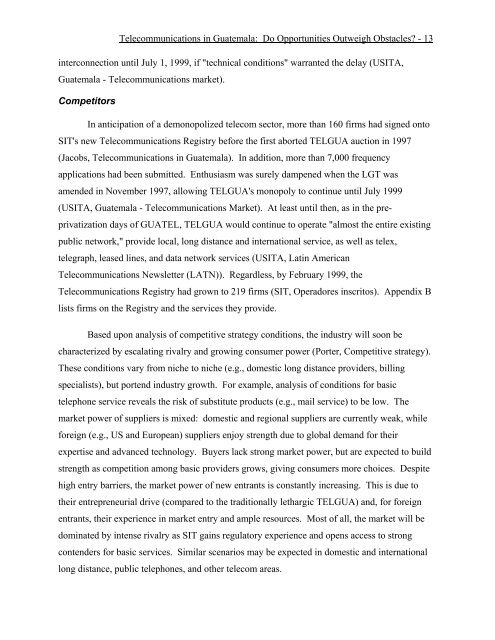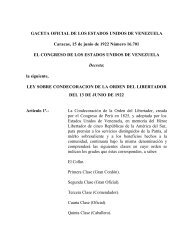Guatemalan Telecom Privatization Study, 2000
Guatemalan Telecom Privatization Study, 2000
Guatemalan Telecom Privatization Study, 2000
You also want an ePaper? Increase the reach of your titles
YUMPU automatically turns print PDFs into web optimized ePapers that Google loves.
<strong>Telecom</strong>munications in Guatemala: Do Opportunities Outweigh Obstacles? - 13<br />
interconnection until July 1, 1999, if "technical conditions" warranted the delay (USITA,<br />
Guatemala - <strong>Telecom</strong>munications market).<br />
Competitors<br />
In anticipation of a demonopolized telecom sector, more than 160 firms had signed onto<br />
SIT's new <strong>Telecom</strong>munications Registry before the first aborted TELGUA auction in 1997<br />
(Jacobs, <strong>Telecom</strong>munications in Guatemala). In addition, more than 7,000 frequency<br />
applications had been submitted. Enthusiasm was surely dampened when the LGT was<br />
amended in November 1997, allowing TELGUA's monopoly to continue until July 1999<br />
(USITA, Guatemala - <strong>Telecom</strong>munications Market). At least until then, as in the preprivatization<br />
days of GUATEL, TELGUA would continue to operate "almost the entire existing<br />
public network," provide local, long distance and international service, as well as telex,<br />
telegraph, leased lines, and data network services (USITA, Latin American<br />
<strong>Telecom</strong>munications Newsletter (LATN)). Regardless, by February 1999, the<br />
<strong>Telecom</strong>munications Registry had grown to 219 firms (SIT, Operadores inscritos). Appendix B<br />
lists firms on the Registry and the services they provide.<br />
Based upon analysis of competitive strategy conditions, the industry will soon be<br />
characterized by escalating rivalry and growing consumer power (Porter, Competitive strategy).<br />
These conditions vary from niche to niche (e.g., domestic long distance providers, billing<br />
specialists), but portend industry growth. For example, analysis of conditions for basic<br />
telephone service reveals the risk of substitute products (e.g., mail service) to be low. The<br />
market power of suppliers is mixed: domestic and regional suppliers are currently weak, while<br />
foreign (e.g., US and European) suppliers enjoy strength due to global demand for their<br />
expertise and advanced technology. Buyers lack strong market power, but are expected to build<br />
strength as competition among basic providers grows, giving consumers more choices. Despite<br />
high entry barriers, the market power of new entrants is constantly increasing. This is due to<br />
their entrepreneurial drive (compared to the traditionally lethargic TELGUA) and, for foreign<br />
entrants, their experience in market entry and ample resources. Most of all, the market will be<br />
dominated by intense rivalry as SIT gains regulatory experience and opens access to strong<br />
contenders for basic services. Similar scenarios may be expected in domestic and international<br />
long distance, public telephones, and other telecom areas.
















